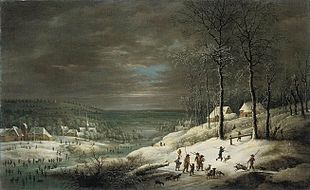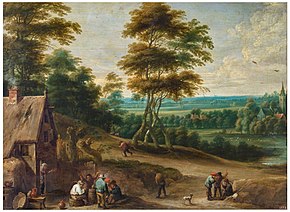Lucas van Uden

Lucas van Uden(18 October 1595 – 4 November 1672) was a leading Flemishlandscapepainter,draughtsman and engraver, who lived and worked in Antwerp. He was a leading landscape painter who collaborated with various local figure painters. His most original works are his drawings.[1]
Life
[edit]Lucas van Uden was born inAntwerpas the son of Artus van Uden and Joanna Tranoy. His father was Antwerp's city painter, a position which required him to paint the City's buildings and refurbish and gild the statues of the city and the pieces used in theommegang.Lucas had a brother Jacob who also became a landscape painter. Lucas likely studied with his father as he was never registered with theGuild of Saint Lukeas a pupil. He registered only as a master at the Guild in the capacity of a 'wijnmeester' (master's son') in 1626–27 when he was already 32 years old.[2]

Lucas had an extramarital relationship with Agatha Musson. She gave birth on 24 October 1620 to a son who was named Lucas. On 14 February 1627 Lucas van Uden married Anna van Woelput with whom he had 8 children, two of whom were born before the couple had married. Lucas had another illegitimate child with Willemijntje van den Brande in 1630.[2]
He was active in Antwerp for most of his life except for a period around 1649 when he was recorded as no longer living in the city.[1]He was very successful and could live very comfortably in central Antwerp.[2]
He was the teacher ofJan Baptist Bonnecroy,Philips Augustijn ImmenraetandGillis Neyts.He likely also trained his children. His daughter Maria van Uden became a painter and married the painterCharles Emmanuel Biset.His son Adriaen was also active in Antwerp as a painter.[3]
He died in Antwerp in 1672.[3]
Work
[edit]
Lucas van Uden was principally a landscape painter. Some of his landscapes were winter landscapes such as theWinter Landscape with Hunters(private collection).
Although he was never part ofPeter Paul Rubens' studio, his works are partly indebted to that leading Antwerp master. His technique with its attention to detail, particularly in his smaller works, and his search for decorative elements in the larger paintings place him in the same tradition asJan Brueghel the ElderandJoos de Momper.[1]The contrast between areas with dark and cold colours with warm colours in his work also calls to mind the work ofJan Brueghel the ElderandJoos de Momper.[4]General characteristics of is work are a tonally-green recessive view punctuated by slender trees and populated by incidentalpastoralandpeasantfigures.[1]His compositions are usually built up as follows: in the foreground there is a bank with leafy trees, one of which is inclined in order to break the monotony and lead the view of the spectator towards the center of the composition, in which appear as the main motive groups of trees, fields or villages, which are shown cut out against a background of mountains, lacking any dramatic allusion.[4]

While his landscape paintings are rather schematic, his drawings which were reportedly made directly from nature are more spontaneous and realistic and display his true talent.[1]
Van Uden is known to have collaborated withDavid Teniers the YoungerandJan Brueghel the Youngerwho painted the staffage in his landscapes. An example is theVillagers having a meal(Prado,Madrid), a collaboration with David Teniers the Younger.[1]
Van Uden is often associated with fellow landscape painterJan Wildenswho frequently collaborated with Rubens. However, unlike for Wildens, there is no evidence van Uden ever painted the landscapes for Rubens. Rubens also never added the staffage to van Uden's landscapes.[1]Van Uden made various copies of Rubens' compositions such as theLandscape with a rainbow(Kunsthistorisches Museum), which is a copy of Rubens'Landscape with a rainbowin theHermitage.
Lucas van Uden produced many etchings some of which are part of the collections of theRijksmuseumand theBritish Museum.[5][6]Some of his designs were also etched by his pupil Philips Augustijn Immenraet.[6]
References
[edit]- ^abcdefgHans Devisscher. "Uden, Lucas van." Grove Art Online. Oxford Art Online. Oxford University Press. Web. 25 February 2017
- ^abcFrans Jozef Peter Van den Branden,Geschiedenis der Antwerpsche schilderschool,Antwerpen, 1883, pp. 43–45(in Dutch)
- ^abLucas van Udenat theNetherlands Institute for Art History(in Dutch)
- ^abLucas van Udenat the Prado(in Spanish)
- ^Lucas van Udenat the Rijksmuseum(in Dutch)
- ^abLucas van Udenat the British Museum
External links
[edit] Media related toLucas van Udenat Wikimedia Commons
Media related toLucas van Udenat Wikimedia Commons
